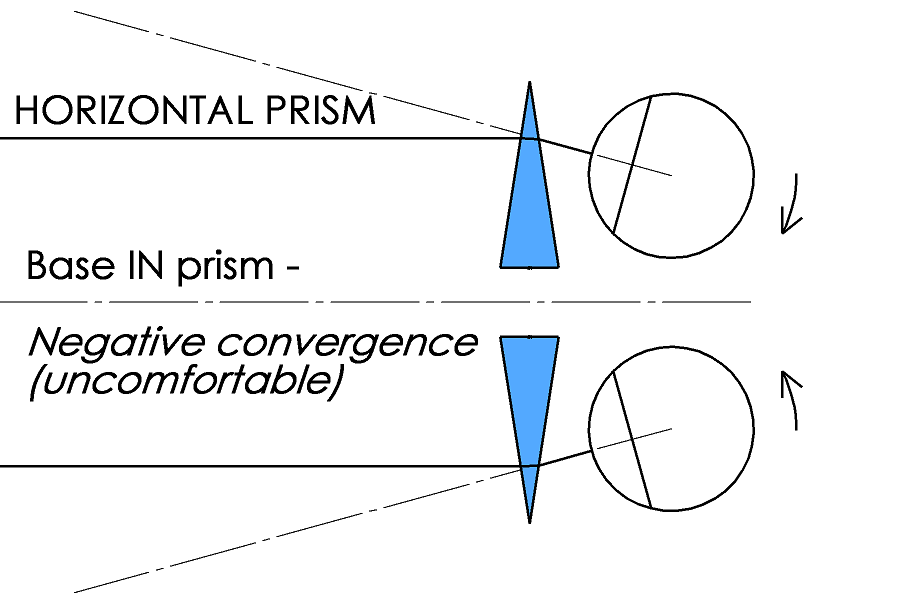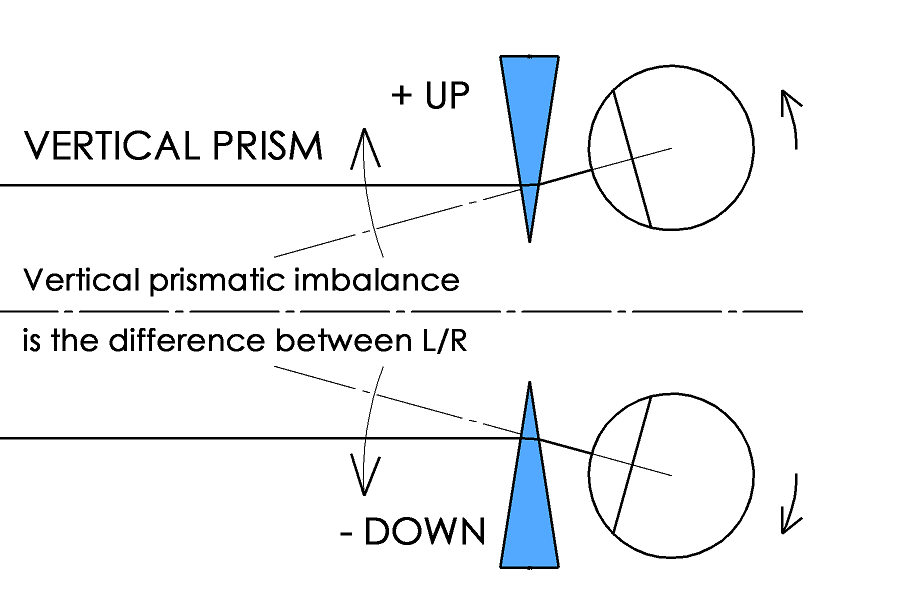ABCO Blog/News
As a leader in the design and manufacture of optical molds, ABCO is often asked to share insights into our areas of expertise.
Below is a list of linked articles, papers, newsletters and more we are proud to share
with you.
Blog Posts
OPTICS 101
July 30, 2015
OPTICS 101
The purpose of this blog is to explain basic optical principles, optical effects and standards that must be dealt with by lens designers and manufacturers. Very often we have to explain these principles to customers, so we thought it a good idea to start here.
Refraction
First off, as we all know, light refracts as it goes though surfaces; from one material to another, the rays of light bend. The amount by which they bend is affected by the angle of incidence and the index of refraction of the material. At some angle, light no longer refracts, but will reflect, bouncing off the surface rather than going through it. The physical principle that governs this is known as Snell's Law.

By definition, the index of refraction of air is 1.0. Each material will have its own index of refraction; crown glass can be 1.53, polycarbonate 1.586, acrylic... and so on.
Prisms
Prisms are lenses with flat surfaces.
If it is a flat plate, light enters the first surface and deviates through the prism material. As it travels through the second surface, parallel to the first, the ray is refracted back at the same angle as it entered the first surface, however, it has probably shifted.
If the prism is triangular, the surfaces are not parallel and light will exit at a different angle, always towards the base of the prism. In a lens, this is how we define the direction of prismatic deviation, whether it is “Base IN” or “Base OUT”. This is a very important notion to understand regarding the direction of prismatic deviations.

Base OUT prism makes our eyes converge. This is called positive (+) convergence.
Base IN prism will make the rays converge, and the eyes will diverge. This is called negative (-) convergence.
When we talk about prismatic imbalance, we compare both eyes with each other.
- If the prism effect both go in the same direction (IN or OUT), then we add them.
- If the prism effect is base IN in one eye, and base OUT in the other, we subtract them.
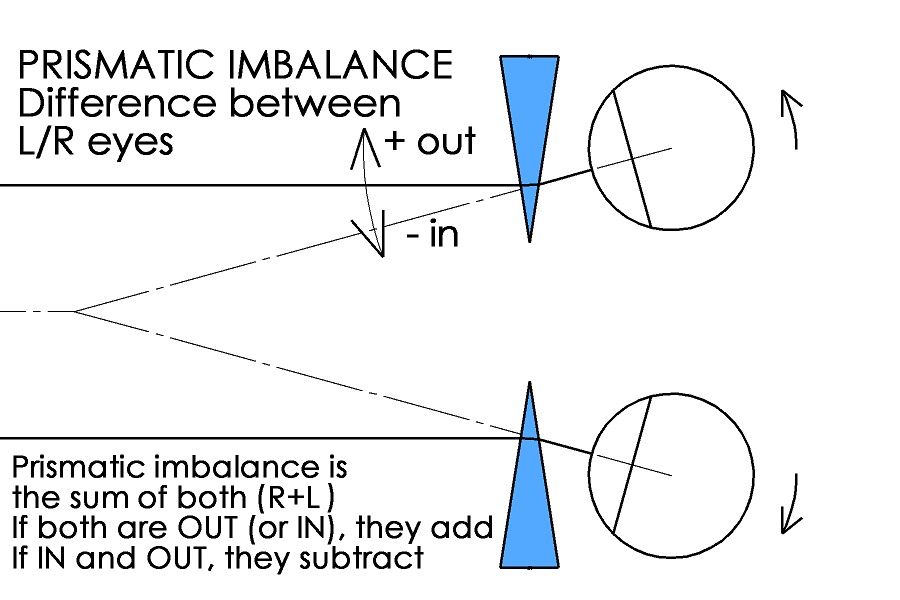
Other optical effects of lens materials
Now, the index of refraction varies according to the wavelength of light. For this reason, white light, which is composed of all colors, will tend to spread out as it travels through a strong prism. In thin lens design, this can cause an effect called “chromatic aberration”, where colors can separate and we see rainbow halos around objects. This generally occurs with higher power lenses and certain materials, but with low or zero power lenses, called “plano lenses,” it is generally not an issue.
When light travels through the lens material, it can loose intensity, which is called transmission. The thicker the material, the more loss of transmission we can expect.
When we tint lens materials, we filter out certain frequencies of light selectively. We may do this for specific purposes, such as enhancing contrast, or filtering specific frequencies that may harm the eye, such as UV light or lasers of a certain frequency. The notion of “optical density” is important when the thickness of our lens varies.
With lens tints, the issue of color recognition becomes important, such as traffic signal lights in particular. This is why the standards have requirements pertaining to color.
Lenses
Lenses generally have two surfaces that can be flat or curved.
- Convex surfaces will generate positive power, making rays converge.
- Concave surfaces will generate negative power, making rays diverge.
- Flat surfaces will not generate power.
Lenses that generate low or no power are called PLANO lenses. They can be curved yet generate no power, as if they were flat, hence the name. Most plano lenses we deal with are thin, concave on the inside and convex on the outside. The fact they have no power is not by chance, it is by design.
Astigmatism
When power is not the same in two planes, there is an optical effect that arises called astigmatism, or cylinder. The term cylinder comes from the fact that a cylindrical lens is:
- curved in one plane and can generate power, and
- is straight in the other and will not generate power.
This creates a power imbalance we call astigmatism. When power is balanced, the lens of the eye can focus in both planes the same way and the image is clear. However, when we have astigmatism, the eye cannot focus and the image is blurred. This is the problem with astigmatism and we will loose resolving power. This is most annoying and causes eye fatigue.
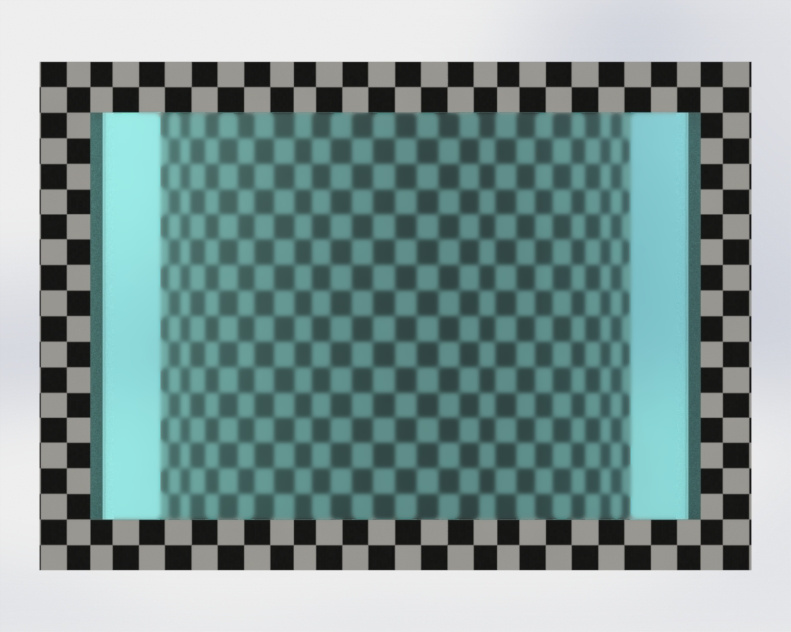
In this ray-traced image we see the optical effects of negative power in an uncorrected cylindrical lens. There is no vertical power in the vertical direction, so there is no change in apparent image size in that direction. However, in the horizontal plane, the negative power reduces the image. Moreover, since the focal lengths are different in both planes, the eye cannot focus and this causes blurring of the image and loss of resolution.
Resolution
The test for optical clarity of the image is the resolution test. We look at a test pattern through the lens with a telescope and try to count the lines; the finer, the better the resolving power of our lens. This is a similar principle to the letter chart the sight specialists use.
A lens focuses the image over a larger surface of the lens, so that many things can affect its resolution:
- Astigmatism,
- A non perfect optical surface from machining, polishing or the molding process (spherical aberration, “potato chipping” of a cylinder, etc.),
- Surface imperfections from irregular lens coating, waves, ripples, divots, pits, etc.
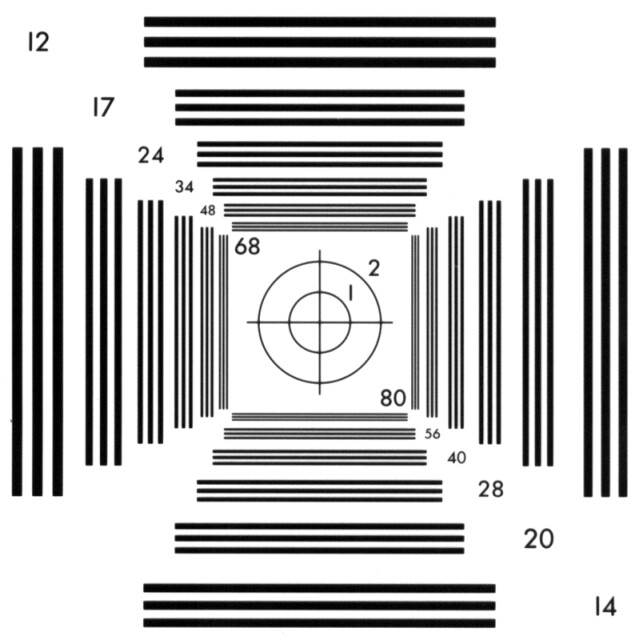
“Cosmetic” lens quality
This refers to many things, from the above surface imperfections to contaminants in the resin causing dots, specks, inclusions, bubbles and such. Most of these defects are assessed visually by looking at the lens with a backlight or projecting through the lens with a collimated light source (projector). Another useful trick is to look at linear objects at a distance, such as fine Venetian blinds, with the lens at arm's length.
Once we sharpen our senses, we never see lenses in the same way again. There is a world of difference in optical quality to be aware of. The ideal plano lens is a lens that would have no effects whatsoever. Such perfection can only exist in a perfect world. In fact, optical design is a lot about the judicious balancing of trade-offs between optics, protection and processing. There is no right answer, but there is one that is generally better.
Thin lens design
The equation for designing thin lenses was discovered over a century ago by Alvaar Gullstrand, a Nobel Laureate who studied the physics of the human eye. It has been used to design lenses ever since.
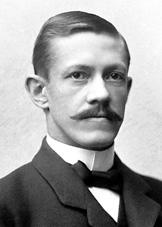
The equation is actually quite simple and it looks like this:

Whereas:
P is Power in diopters (units of power)
f is the focal length (in meters)
n is the index of refraction of the lens material (relative to air)
R1 and R2 is the radii of curvature (in meters)
d is the thickness in the center of the lens (in meters)
Of course, this is an approximate method for designing lenses because it provides the power on the optical center of the lens. The proper way to design lenses is by ray-tracing. There are many specialized software that exist for accurate lens design.
But this is only the tip of the iceberg. There area many other effects and principles that you should also be aware of.
Power generates prism
We rarely look perfectly “down the barrel” of a lens as worn and this must be carefully taken into consideration in optical design. In fact, our eyes are separated, and this separation varies from person to person depending on inter-pupillary distance, or IPD. The distance away from optical center is what we call decentration.
By definition, a lens with 1 diopter of power, will generate 1 diopter of prism for every centimeter of decentration.
Off-axis viewing
Often lenses have what we call pantoscopic angle. This often occurs because of how the lens must fit the face, requiring more clearance for the eyewear frame and the eyebrows than the thin lens we would like close to our cheek. This angle can introduce issues with prism and astigmatism.
The optical standards generally test for horizontal line of sight, as if we were looking at a point on the horizon. When we correct lenses to optimize for this, they become directional, that is, we favor better forward gaze at the expense of off axis viewing. Remember, optical design is often the law of trade-offs and the ideal lens is utopia.
When our eyes rotate, we often look obliquely through the lens. Many optical effects come into effect outside the standards and can also be considered in lens design. In some military standards, such as MIL-V-435D, we strive for best overall “omni-directional” viewing. In this case, we must tolerate negative power in these lenses in order to have better vision throughout the visual field.
This brings up the topic of visual comfort in a lens which we can explore in a future blog.
The manufacturing of lenses
Apart from the theoretical, there is a very practical side to lens design: manufacturing. Though the laws of physics are extremely precise and accurate, obtaining that level of accuracy in a finished lens is a tall order. Many cumulative tolerances come into play:
- The precision at which we machine the optical mold inserts,
- The precision at which they are located in the mold, with respect to each other,
- The precision at which we polish the mold inserts,
-
The process control we have in the molding process:
- Gating, mold flow and fill,
- Temperature control in the mold,
- Cycle time, etc.
- Hard coating is a dip process relying on surface tension of fluids.
- And so on...
Conclusion
Optics follows the laws of physics in the most reliable and accurate way. However, there is no truly perfect lens.
Making a clear plastic part is easy, but making a lens is a science and an art. This is what differentiates common lenses from exceptional ones.
Paul Isabelle.
Paul Isabelle has been designing lenses for over 25 years for the sport, industrial, institutional, medical and military markets. ABCO Tool & Die asked him to write a series of blogs for their customers covering a wide variety of topics that they have had to explain regularly. If there is a topic you would like to know more about, please contact us and we will be pleased to respond.
Introducing ABCO Tool & Die
June 26, 2014

If you’ve found this blog, it’s because you know what you’re looking for. Allow us a minute to introduce our company. ABCO Tool & Die is a mold manufacturing company that specializes in mold building for the world of high performance optical products. Users of our molds range from goggle makers, eyeglass manufacturers and high-tech manufacturers to the defense and law enforcement industries. Over the past 30 plus years ABCO has perfected its understanding and execution of the art of building precision optical molds. ABCO optical molds deliver precision, high-clarity optics for specialty or everyday applications.
Articles
ABCO Tool & Die’s ‘visionary’ business strategy provides a clear path to growth
Plastics Today, July 21, 2014
When ABCO Tool & Die Inc. started in business nearly 40 years ago, the company was your typical mold builder. However, it then received an opportunity from one of the major manufacturing companies in the state of Massachusetts: Polaroid.
ABCO Tool & Die, Inc.: Eyes on the Prize
MoldMaking Technology, November 2008
Continuing to focus on its specialty of producing optical molds, this moldmaker’s vision of becoming a resource to its customers is realized by equipment and technology upgrades.
Visionary specialists
Injection Molding, June 2006
A keen-eyed Cape Cod moldmaker spotted opportunities for growth in lens and optical molds on the horizon more than two decades ago, set sail, and never looked back.
Papers
Manufacturing Plastic Injection Optical Molds
Invited Paper, 2008
ABCO Tool & Die, Inc. is a mold manufacturer specializing in the manufacturing of plastic injection molds for molded optical parts. The purpose of this presentation is to explain the concepts and procedures required to build a mold that produces precision optical parts.
